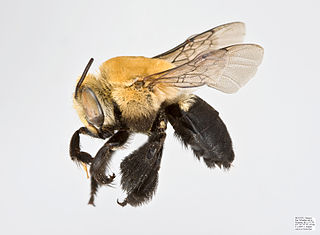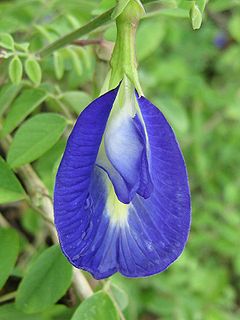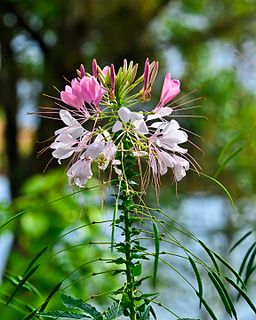
Nepeta is a genus of flowering plants in the family Lamiaceae. The genus name is reportedly in reference to Nepete, an ancient Etruscan city. There are about 250 species.

The genus Centris contains circa 250 species of large apid bees occurring in the Neotropical and Nearctic realms, from Kansas to Argentina. Most females of these bees possess adaptations for carrying floral oils rather than pollen or nectar. They visit mainly plants of the family Malpighiaceae to collect oil, but also Plantaginaceae, Calceolariaceae, Krameriaceae and others. Recent studies have shown they are sister to the corbiculate bees, the most well-known and economically important group of bees

Gaultheria is a genus of about 135 species of shrubs in the family Ericaceae. The name commemorates Jean François Gaultier of Quebec, an honour bestowed by the Scandinavian Pehr Kalm in 1748 and taken up by Carl Linnaeus in his Species Plantarum. These plants are native to Asia, Australasia and North and South America. In the past, the Southern Hemisphere species were often treated as the separate genus Pernettya, but no consistent reliable morphological or genetic differences support recognition of two genera, and they are now united in the single genus Gaultheria.

Monarda is a genus of flowering plants in the mint family, Lamiaceae. The genus is endemic to North America. Common names include bergamot, bee balm, horsemint, oswego tea, the first inspired by the fragrance of the leaves, which is reminiscent of bergamot orange. The genus was named for the Spanish botanist Nicolás Monardes, who wrote a book in 1574 describing plants of the New World.

Persoonia, commonly known as geebungs or snottygobbles, is a genus of about one hundred species of flowering plants in the family Proteaceae. Plants in the genus Persoonia are shrubs or small trees usually with smooth bark, simple leaves and usually yellow flowers arranged along a raceme, each flower with a leaf or scale leaf at the base. The fruit is a drupe.

Clitoria is a genus of mainly tropical and subtropical, insect-pollinated flowering pea vines.

Sinningia is a genus of flowering plants in the family Gesneriaceae. It is named after Wilhelm Sinning (1792–1874), a gardener of the Botanische Gärten der Friedrich-Wilhelms-Universität Bonn. There are about 65 species of tuberous herbaceous perennials, all occurring in Central and South America, with the greatest concentration of species occurring in southern Brazil.

Senna, the sennas, is a large genus of flowering plants in the legume family. This diverse genus is native throughout the tropics, with a small number of species in temperate regions. The number of species is estimated to be from about 260 to 350. The type species for the genus is Senna alexandrina. About 50 species of Senna are known in cultivation.

Cleome is a genus of flowering plants in the family Cleomaceae, commonly known as spider flowers, spider plants, spider weeds, or bee plants. Previously, it had been placed in the family Capparaceae, until DNA studies found the Cleomaceae genera to be more closely related to the Brassicaceae than the Capparaceae. Cleome and clammyweed, can sometimes be confused. The simplest way to differentiate the two is to compare the seedpods which project out or down on cleome and up on clammyweed.

Mirbelia is a plant genus belonging to the family Fabaceae. It is endemic to Australia, occurring in every mainland state except South Australia.

Acleisanthes is a genus of flowering plants in the Bougainvillea family, Nyctaginaceae. There are currently 16 species. The generic name is derived from the Greek words ακλειοτος (akleistos), meaning "not closed", and ανθος (anthos), meaning "flower". Plants of this genus are known commonly as trumpets due to the elongated, open-ended shape of their flowers. These are arid-adapted perennials with thick taproots which are usually compact and low to the ground or slightly ascending. An individual plant may have cleistogamous flowers as well as opening flowers which are usually nocturnal as a water-saving adaptation and are pollinated by night-flying or crepuscular insects such as hawkmoths. Flowers are usually white, sometimes yellow. These plants are native to the Chihuahuan and Sonoran Deserts of Mexico and the United States.

Gahnia is a genus of sedges native to China, Southeast Asia, New Guinea, Australia, New Zealand and a number of Pacific Islands. The common name is due to the toothed margins. It often forms tussocks.

Diascia is a genus of around 70 species of herbaceous annual and perennial flowering plants of the family Scrophulariaceae, native to southern Africa, including South Africa, Lesotho and neighbouring areas.

Amasonia is a genus of plants in the family Lamiaceae, native to South America and to the island of Trinidad.

Machaerina (twigrush) is a genus of flowering plants in the sedge family. Its species occur in tropical America, the West Indies, Malesia, Australia and the Pacific region. The name comes from the Greek machaira, alluding to the shape of the leaves in the type species – Machaerina restioides.

















